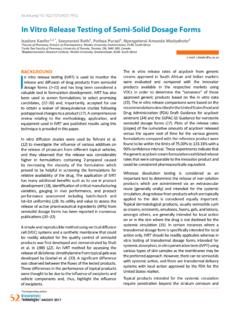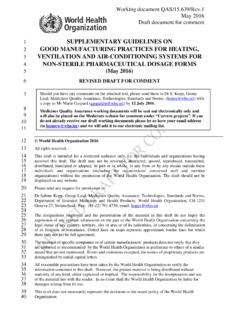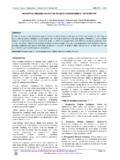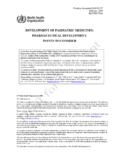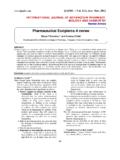Transcription of A Quality by Design Approach for Coating Process Parameter ...
1 May-June 2017 Indian Journal of pharmaceutical Sciences345 Research PaperFilm Coating is an essential unit operation in tablet manufacturing. Most tablet dosage forms in the market are film coated. The main purpose for Coating of immediate release film dosage form is to provide colour identification, to enhance the stability, taste masking. It is also noted that film Coating can improve the processibility and handling during pharmaceutical manufacturing and is the most popular Coating technique and is widely used in pharmaceutical industry. The film Coating formulation involves a polymer, which acts as film former along with various other additives like plasticizer, antitack agent and suitable pigments with water often used as the preferred Coating was considered as an art rather than a science.
2 However, as technology progressed, the Coating formula and Process optimization using scientific methods have taken predominance over the traditional film Coating methods. The Process of film Coating involves consistently depositing and drying a uniform Coating formulation onto the surface of a substrate so as to form a uniform film. Thus, for a good tablet Coating , control of Process parameters is very important. A poorly developed film Coating Process may result in various tablet defects like chipping, edge erosion, twining, colour variation from tablet to tablet, poor solubility, elegance and stability of product[1-4]. A few of the Quality attributes for a final coated product could be the following; moisture content, surface roughness, gloss, Coating efficiency, Coating uniformity, colour uniformity and disintegration , a Process optimization study to identify the critical film Coating parameters would be needed in order to ensure a robust Process .
3 Optimization of the Process parameters were earlier done by one factor at a time (OFAT) Approach but it was time consuming and less sensitive to Parameter interactions. A Quality by Design (QbD) Approach , involving multivariate analysis can be beneficial as the study can be done by variations of multiple factors at one time. There have been multiple studies directed towards identification and optimization of Coating Process parameters using QbD Approach starts with identifying the target product profile (TPP), based on the prior knowledge of A Quality by Design Approach for Coating Process Parameter OptimizationB. K. NAYAK, P. ELCHIDANA AND P. K. SAHU*School of pharmaceutical Sciences, Siksha O Anusandhan University, Kalinga Nagar, Ghatikia, Bhubaneswar-751 003, IndiaNayak, et al.
4 : A Quality by Design Approach for Coating Process Parameter Optimization Film Coating is a thin polymer layer applied on to a solid dosage form. Quality by Design Approach was explored to optimize the tablet Coating Process using Opadry , an optimized one step film Coating system. A central composite Design was chosen by considering independent variables as inlet temperature, atomization air pressure, spray rate and dependent variables as weight gain and tablet surface roughness. Non-linear regression models were developed for response variables. The model was used to achieve an optimized response characteristic of weight gain, surface roughness with predicted input variables of inlet air temperature, atomization air pressure and spray rate.
5 With optimized Process parameters tablet has been coated and the suitability of the model determined. The results demonstrated the overall reliability and effectiveness of the proposed Quality by Design Approach to the derived model and provides useful tool to help optimize the film Coating Process . Key words: Quality by Design Process optimization, Design of experiment, Coating , surface roughness, critical Process parameters, Process analytical technology, Coating Process Parameter optimization*Address for correspondenceE-mail: is an open access article distributed under the terms of the Creative Commons Attribution-NonCommercial-ShareAlike License, which allows others to remix, tweak, and build upon the work non-commercially, as long as the author is credited and the new creations are licensed under the identical termsAccepted 05 April 2017 Revised 29 December 2016 Received 08 August 2016 Indian J Pharm Sci 2017.
6 79(3) 2017 Indian Journal of pharmaceutical Sciences346formulation, Process and the identifying critical Quality attributes (CQAs) that have a significant impact on the achieving the target profile. The CQAs are typically a combination of variety of factors related to the formulation the critical material attributes (CMAs) or critical Process parameters (CPPs). Once the CQAs are identified, their effect on target profile is known and can help the manufacturer to develop a Design space. Development of Design space can help to understand the effects of a combination of Process parameters to get the desired response and implement a control strategy to monitor the product in its life cycle[5,6].International Council on Harmonization (ICH) Q9 indicates risk assessment as a valuable science-based Process used in Quality risk management.
7 Various risk assessment tools are recommended in ICH Q9 guidelines Quality risk management guidelines like Ishikawa, failure mode and effects analysis (FMEA), Pareto and Design of experiments (DOE). The objective of this study is to use the tools like FMEA and DOE for Coating Process optimization. The FMEA is about identification of potential failure modes for a Process . It helps in focus on risk associated with failure modes, rank the issues in terms of importance and carryout corrective actions for potential failures whereas the DOE is a statistical tool, which is used for multivariate analysis by screening, optimizing and testing robustness of Process . Various models are available to conduct the DOE study like factorial, response surface methods and the Taguchi State Food and Drug Administration (USFDA) also published guidelines, which recommend the implementation of Process analytical technology (PAT) in pharmaceutical processing.
8 Developing Process analytical technologies assures robustness of product throughout its life cycle and provided online monitoring of the Process . Recent innovations in pharmaceutical manufacturing have helped in implementation of PAT much easier for various processes. For Tablet Coating Process , PAT may be implemented using various spectroscopic and imaging techniques to monitor the Coating uniformity and Coating thickness[7,8]. Several articles have been published around Coating Process optimization using Design of experiments tool. Brock et al. analysed the CPPs for inter tablet Coating uniformity in an active pan Coating Process using Terahertz pulsed imaging[9]. In this work the Coating uniformity was assessed by calculating the coefficient of variation (CV) of Coating thickness and the CV of active pharmaceutical ingredient (API) content measured by high performance liquid chromatography (HPLC)[9].
9 Similarly, DOE methods were used to quantify the effects of changes in Coating Process conditions on the Quality and performance of film-coated tablets. In another articles, factorial Design was employed to study the effect of independent variables (atomizing air pressure and inlet air temperature) on dependent variables (sticking and picking, orange peel effect, surface roughness, Coating Process efficiency) by using 32 full factorial designs, Design expert version software by Patel et al.[10]. In yet another work, the identification and optimization of CPPs of newly developed super cell quasi continuous coater was done using Box Behnken Design a multivariate response surface methodology by Cahyadi et al.[11]. Yet another significant work in this area was to calculate the change of surface roughness and the development of the film during the film Coating Process using laser profilometer roughness measurements, scanning electron microscope (SEM) imaging and energy dispersive X-ray (EDX) analysis was studied by Seitavuopio et al.
10 [12].All the above documented information gave impetus to this work, which adopted a multivariate statistical tool DOE for Process optimization. The objective of this work was to perform failure mode and effective analysis for a typical Coating Process and later optimize the critical factors using DOE methodology. MATERIALS AND METHODSP reparation and selection of critical input parameters of tablet: ICH guidelines Q9 recommends to perform risk assessment to find out critical Process Parameter and potential failures in products or processes. Risk assessment starts with probability of outcome after Process of product. Various tools are available to carry out risk analysis like supporting statistical tools, risk ranking and filtering, preliminary hazard analysis (PHA), hazard operability analysis (HAZOP), hazard analysis and critical control points (HACCP), fault tree analysis (FTA), failure mode, effects and criticality analysis (FMECA), FMEA, basic risk management facilitation methods (flowcharts check sheets, Process mapping, cause and effect diagrams (also called an Ishikawa diagram or fish bone diagram).)


